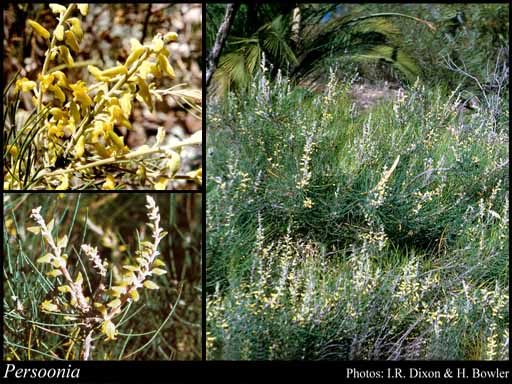- Reference
- Trans.Linn.Soc.London,Bot. 4:215 (1798)
- Name Status
- Current

Scientific Description
Common name. Snottygobble. Family Proteaceae.
Habit and leaf form. Small trees, or shrubs (bark smooth, corky or flaky); evergreen. To 0.1–25 m high. Mesophytic, or xerophytic. Leaves small to medium-sized; alternate (mostly), or opposite, or whorled; usually spiral; decussate; 3 per whorl; leathery, or fleshy; shortly petiolate to sessile; non-sheathing; simple; epulvinate. Leaf blades entire; flat, or solid; terete, or semi-terete, or solid/angular; linear, or ovate, or obovate, or oblong, or elliptic (or falcate). Leaves without stipules. Leaf blade margins entire. Leaves without a persistent basal meristem. Stem anatomy. Secondary thickening developing from a conventional cambial ring.
Reproductive type, pollination. Fertile flowers hermaphrodite. Unisexual flowers absent. Plants hermaphrodite. Entomophilous.
Inflorescence and flower features. Flowers solitary, or aggregated in ‘inflorescences’. Inflorescence few-flowered to many-flowered (1–70-flowered). Flowers in racemes. Inflorescences terminal, or axillary; abbreviated to elongate, anauxotelic or auxotelic; flowers subtended by scale leaves or leaves. The fruiting inflorescence not conelike. Flowers pedicellate; bracteate; small to medium-sized; regular, or very irregular; when irregular, zygomorphic. The floral asymmetry when present, involving the perianth and involving the androecium. Flowers 4 merous; cyclic; tetracyclic. Floral receptacle developing a gynophore, or with neither androphore nor gynophore. Free hypanthium absent. Hypogynous disk present; extrastaminal; of separate members (comprising 2 or 4 glands, the anterior pair equal to posterior pair or much reduced or absent). Perianth of ‘tepals’; 4; 1 -whorled; free (but usually coherent towards base); with or without lateral ‘wings’; hairy (on outside), or glabrous; yellow (usually), or green, or red (markings). Androecial members definite in number. Androecium 4. Androecial members adnate (to tepals, sometimes free at tips); all equal, or markedly unequal (? when one member infertile); free of one another; 1 -whorled. Androecium usually exclusively of fertile stamens, or including staminodes. Staminodes 1; representing the anterior member. Stamens 3, or 4; all more or less similar in shape; reduced in number relative to the adjacent perianth, or isomerous with the perianth (usually). Anthers all alike; basifixed; straight, or recurved (rarely flattened); non-versatile; dehiscing via longitudinal slits; sub latrorse to introrse; four locular; tetrasporangiate; appendaged (appendage straight to recurved), or unappendaged. Gynoecium 1 carpelled. The pistil 1 celled. Gynoecium monomerous; of one carpel; superior. Carpel stylate; apically stigmatic. Style prominently curved, or straight (or slightly sinuous). Carpel 1 ovuled, or 2 ovuled. Placentation marginal, or apical. Ovary shortly stipitate. Styles becoming exserted. Ovules funicled, or sessile; non-arillate; orthotropous, or anatropous, or amphitropous, or hemianatropous.
Fruit and seed features. Fruit falling from the plant before the next growing season; fleshy. The fruiting carpel indehiscent; drupaceous. Endocarp not ribbed (smooth). Fruit 1 seeded, or 2 seeded. Seeds endospermic. Cotyledons 2(–9). Embryo straight.
Special features. Staminodes free of the stigma.
Geography, cytology, number of species. Native of Australia. Endemic to Australia. Australian states and territories: Western Australia, South Australia, Northern Territory, Queensland, New South Wales, Victoria, Australian Capital Territory, and Tasmania. Northern Botanical Province, Eremaean Botanical Province, and South-West Botanical Province. N=7.
Etymology. After Christian Hendrik Persoon (1755–1837), botanist; born in Cape Colony, worked in Paris; specialist in fungi.